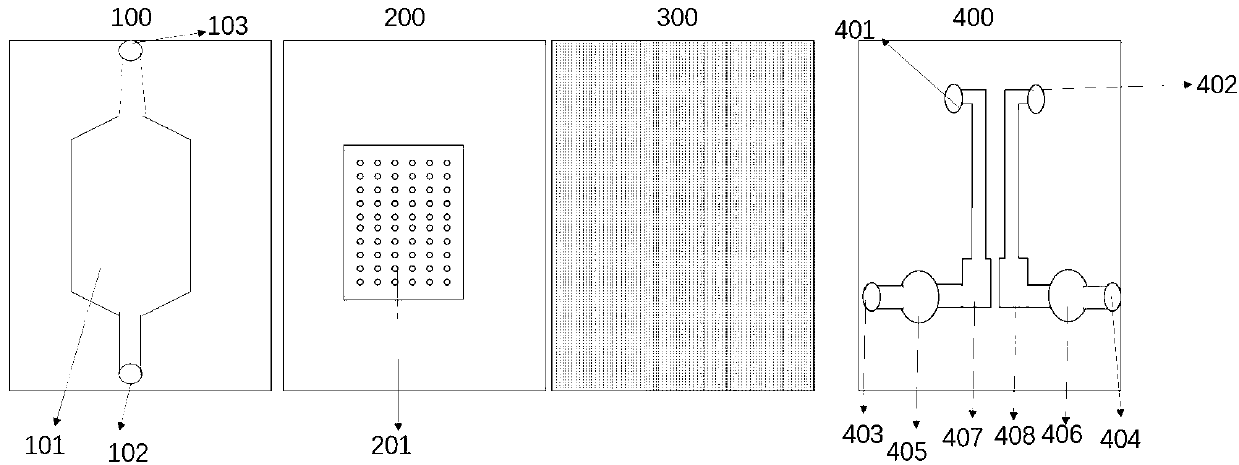Bionic multi-organ chip and preparation method therefor and application of bionic multi-organ chip
A multi-organ and chip technology, applied in the field of bionic multi-organ chip and its preparation, can solve the problems of overlapping upper and lower cells, unfavorable observation, etc., and achieve the effect of enhancing reliability
- Summary
- Abstract
- Description
- Claims
- Application Information
AI Technical Summary
Problems solved by technology
Method used
Image
Examples
Embodiment 1
[0037] Example 1. Preparation of a multi-organ chip
[0038] Design the schematic diagram of the chip by computer, such as figure 1 and figure 2 As shown, the second layer 200 and the third layer 300 constitute the upper layer cell three-dimensional culture area. The middle area of the second layer is a square structure, arranged with porous structures, circular holes 201 with a size of 50-400 microns, and a pitch of 50-100 microns. The third layer is a porous membrane with a size between 0.22-20 microns, and the material is a variety of transparent or translucent microporous membranes such as PC, PET, and PDMS. Filter membranes are used for material exchange. The fourth layer contains independent tissue and organ culture channels. It includes fluid inlets 401, 402 and two fluid outlets 403, 404 respectively. The upper layer and the lower layer have communication areas 407, 408. This area is a rectangular structure with a width larger than the fluid passage, which is co...
Embodiment 2
[0041] Example 2. Construction of bionic multi-organ chip
[0042] Before inoculating cells, the inside of the chip channel needs to be washed 3-5 times with PBS. Firstly, two kinds of cells were respectively inoculated in two independent culture areas on the lower layer. In this example, hepatocytes are taken as an example. After the primary mouse hepatocytes are extracted, they are prepared into a suspension, counted according to the 7th power of 1x10, and inoculated into one of the channels of the lower layer. After the cells settle in the three-dimensional culture area, apply The slow fluid washes away the cells in the microchannel, and only retains the cells in the three-dimensional culture area. In the same manner, cardiomyocytes derived from human induced pluripotent stem cells were inoculated in another channel. Static culture for 12-24 hours to promote liver and cardiomyocytes to form three-dimensional cell spheres.
[0043] After the lower layer of cell spheres is...
Embodiment 3
[0045] Example 3. Drug testing using a bionic multi-organ chip
[0046] This example realizes the co-cultivation of three tissues and organs of liver-heart-ovary cancer. In order to simulate the tumor-killing effect of clinical anticancer drugs, the toxic effect on the myocardium, the toxicity to the liver, and the effect of the drug metabolized by the liver, this embodiment takes doxorubicin as an example. Add doxorubicin-containing medium to the upper ovarian cancer inlet. After passing through the ovarian cancer layer, the culture medium on the upper layer penetrates into the lower layer through the porous membrane, and is respectively received by the liver and heart channels. Slow fluid is applied to the lower layer to promote the diffusion of the culture medium from the upper layer to flow into the lower liver and heart culture areas.
[0047] The drug evaluation implemented in this implementation can simulate multiple clinical cycles of chemotherapy, as well as the chro...
PUM
| Property | Measurement | Unit |
|---|---|---|
| size | aaaaa | aaaaa |
| pore size | aaaaa | aaaaa |
| depth | aaaaa | aaaaa |
Abstract
Description
Claims
Application Information
 Login to View More
Login to View More - R&D
- Intellectual Property
- Life Sciences
- Materials
- Tech Scout
- Unparalleled Data Quality
- Higher Quality Content
- 60% Fewer Hallucinations
Browse by: Latest US Patents, China's latest patents, Technical Efficacy Thesaurus, Application Domain, Technology Topic, Popular Technical Reports.
© 2025 PatSnap. All rights reserved.Legal|Privacy policy|Modern Slavery Act Transparency Statement|Sitemap|About US| Contact US: help@patsnap.com


